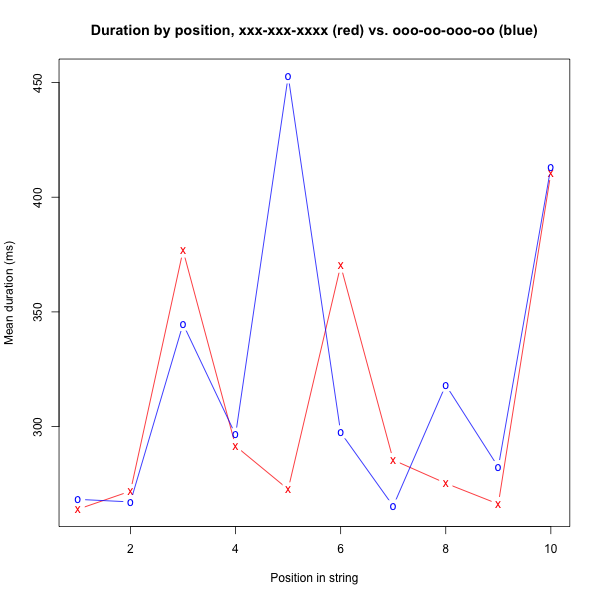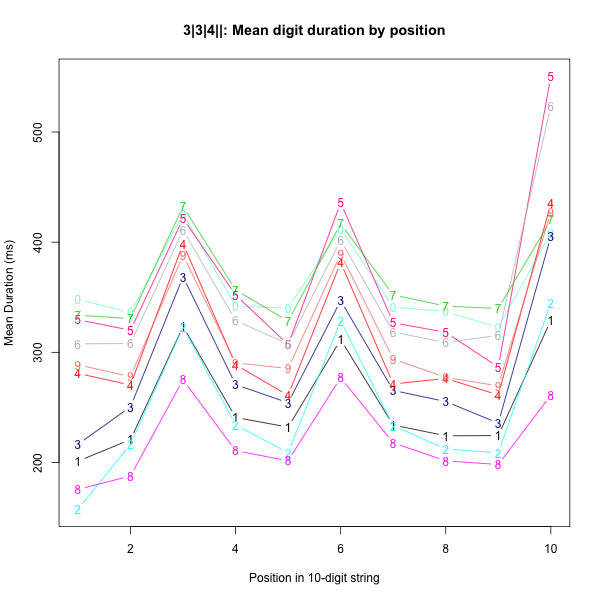English prosodic phrasing
« previous post | next post »
We can read a 10-digit sequence in the style of an American telephone number, 3+3+4 — e.g. 752-955-0354:
Or we could read the same sequence in a 3+2+3+2 pattern, 752-95-503-54:
It won't surprise you to learn that this changes the pattern of average digit durations:
The graph above shows average duration by digit position for 200 10-digit strings, 100 in each phrasing, organized so that every digit occurs equally often (ten times) in each position, and every pair of digits occurs equally often spanning each pair of positions. This was an exercise in phonetics class that I started in the late 1990s — it illustrates the phonetic effects of prosodic phrasing in data that can be replicated in any language with digit words. This particular sample was recorded by me in English.
Obviously the different digits have different durations — the digit averages by position, again from my recording, are shown below:
And of course the phrasing is also expressed in the pitch contour and in other ways as well — but the pattern of timing is an especially clear and easy-to-read sign of the structure. (A similar speech-rate shape applies in ordinary speech as well, as discussed in "The shape of a spoken phrase", 4/12/2006.)
In the Penn Linguistics Department's speaker series a few weeks ago, Janet Dean Fodor gave a fascinating talk titled "Multiple Center-embedding: What's Pronounceable is Comprehensible!" Here's her abstract:
The extreme sentence processing difficulty of doubly center-embedded relative clause (2CE-RC) constructions has elicited many proposed explanations over many decades. Improbably, we offer a phonological explanation. We maintain: (a) that a sentence can't be easily parsed syntactically if it can't be assigned a supportive prosodic contour, and (b) that the flat structure of prosodic phrasing is hard to fit to the densely hierarchical structure of a 2CE-RC sentence.
Examples like (1) are cited in the literature; (2) is from an experiment by Gibson and Thomas (1999). Short or long, both are pronounced awkwardly, with 'list intonation'. Syntactic parsing is so difficult that they are often judged more grammatical when the second VP is (ungrammatically!) omitted, as in (3): this is the "missing VP illusion".
(1) ✔☹ The boy the dog the cat scratched bit died.
(2) ✔☹ The ancient manuscript that the grad student who the new card catalog had confused a great deal was studying in the library was missing a page.
(3) *☺ The ancient manuscript that the grad student who the new card catalog had confused a great deal was missing a page.
We show that the correct nested syntactic structure [NP1 [NP2 [NP3 VP1] VP2 ] VP3] is achievable if prosodic phrasing can package up the center elements [NP2 NP3 VP1 VP2] together. Because prosodic phrases must meet length requirements, this is feasible only if the center constituents are all short, and the outer constituents (NP1 and VP3) are long enough to constitute separate prosodic phrases. This is the case in (4). Experiments confirm that examples like (4) are easier to pronounce and understand than examples like (5), which has the same overall sentence length but has its weight in the wrong places: skinny outer constituents and chubby inner ones. (Read them aloud!)
(4) ✔☺ The rusty old ceiling pipes that the plumber my dad trained fixed continue to leak occasionally.
(5) ✔☹ The pipes that the unlicensed plumber the new janitor reluctantly assisted tried to repair burst.
An explanation is offered on the assumption that syntax-prosody alignment is achieved by syntactic readjustment to the needs of prosody (Chomsky and Halle 1968, contra Selkirk 2000).
Janet engaged the audience by having its members enlisted to read the example sentences. It was clear, I think, that the successful attempts made use of the capability to distinguish among several levels of phrasal prosody, using timing (as in the phone-number examples), pitch, and so on. But I was disappointed that Janet's presentation assumed the idea that only one level of prosodic phrasing is available in English, and when I asked her about this, she suggested (I think) that perhaps German speakers use multiple levels, but that English speakers don't, or something of the sort.
A fuller explanation can be found in Janet Dean Fodor, "Pronouncing and comprehending center-embedded sentences", in Monserrat Sanz et al. Eds. Language Down the Garden Path, 2013, in the section on "a better prosody" (full chapter here).
But I would be shocked to learn that this is really a difference between the German and English languages.


Rod Johnson said,
September 21, 2013 @ 9:33 am
Is there a concept that's the counterpart of "comprehensible" or "parsable" for the production side? Something like "formulatable"? It seems like that would be worth studying if there were a way to do it. Sentences like "The boy the dog the cat scratched bit died" rarely (if ever) occur in spontaneous speech, and it seems like comprehensibility is used as a proxy for production issues that may be quite different than parsing issues.
William said,
September 21, 2013 @ 1:02 pm
I wonder if Pynchon's wonderful evocation of the sound of question-marks at the end of statements or clauses in California-speak is relevant here. I mean I think the following makes pretty reasonable sense, with the question-marks, but is much harder to parse without them:
AJD said,
September 21, 2013 @ 4:07 pm
This is consistent with one of the two naturally-occurring examples of center-embedding I've collected (which is also the one I produced):
"The letters at which teams that play the same sport intersect spell out SMALL WHITE DOG."
…but not with the other:
"The implication that the idea that pay should be differentiated based on effectiveness constitutes 'teacher-bashing' is bizarre."
I think the second example here is readily intelligible, but the inner constituents "should be differentiated based on effectiveness" and "constitutes 'teacher-bashing'" are pretty long and seem to want to have intonational-phrase boundaries after them.
Rubrick said,
September 21, 2013 @ 5:07 pm
This strikes my instincts as being very much on the right track, though the causality seems difficult to determine: Is a sentence incomprehensible because it's unpronounceable, or is pronounceability merely a handy test? The abstract seems to skirt this question rather delicately.
Christian Hege said,
September 21, 2013 @ 9:00 pm
Hm. So maybe the single-syllable words we use or drop at our pleasure (like "that," "which," or "whom") or even a fudging of the pluperfect (with "had") are of more importance prosodically than grammatically.
If I use them to repair a couple of these sentences:
The boy whom the dog that the cat had scratched bit died.
– or –
The pipes that the unlicensed plumber whom the new janitor reluctantly assisted had tried to repair burst.
…they get a little more comfortable to listen to.
The French and Spanish equivalents of all these tiny little words drive me nuts all the time – I gave up on them years ago, thinking they don't really mean anything, we just stick them in places. Could be I was right.
Plane said,
September 22, 2013 @ 10:46 am
For what it's worth, I had to read AJD's second example at least a dozen times to understand it. (Of course, this could be a failing on my part.)
GeorgeW said,
September 22, 2013 @ 3:19 pm
This brought to mind the difficulty my American-system-conditioned mind had with telephone numbers given with a different sequence. While working in Saudi Arabia, people would give a seven-digit phone number with a 4-pause-3 sequence (9-5-5-0 pause 3-5-4). I never was able to grasp this, so I would just write the number down as given then translate into a 3-pause-4 sequence (9-5-5 pause 0-3-5-4).
Aaron E. said,
September 22, 2013 @ 4:35 pm
AJD, your second example is not a genuine doubly-center-embedded relative. Neither subordinate clause is actually a relative; they are both complement clauses (of "implication" and "idea," respectively).
JS said,
September 22, 2013 @ 9:25 pm
OK, this kind of reminds me of that children’s song about the fly the spider the bird the cat the dog the goat the cow the horse the woman swallowed swallowed swallowed swallowed swallowed swallowed swallowed swallowed.
AJD said,
September 23, 2013 @ 1:43 pm
Aaron E.: Hmm, okay, I didn't see that Fodor only claimed her analysis applied to relative clauses. I wonder why it should be different for center-embedded relative clauses than for other center-embeddings, though.